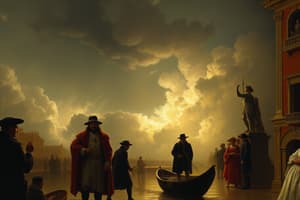Podcast
Questions and Answers
What does unity in art mean?
What does unity in art mean?
There is agreement among design elements.
What is another term for design?
What is another term for design?
Composition.
Unity is also known as harmony.
Unity is also known as harmony.
True (A)
What is one of the most important aspects of visual unity?
What is one of the most important aspects of visual unity?
Intellectual unity and visual harmony are always the same.
Intellectual unity and visual harmony are always the same.
How is visual perception described?
How is visual perception described?
An easy way to gain unity is by proximity, simply placing elements close together.
An easy way to gain unity is by proximity, simply placing elements close together.
What does repetition in unity mean?
What does repetition in unity mean?
Continuation means that our eye searches for a break in unity.
Continuation means that our eye searches for a break in unity.
How is the grid used in design?
How is the grid used in design?
The grid layout is used in print, but never in web design.
The grid layout is used in print, but never in web design.
In creating unity with variation, what may be present?
In creating unity with variation, what may be present?
The principle of unity with variety is conscious and planned by the designer/artist.
The principle of unity with variety is conscious and planned by the designer/artist.
What happens to a composition without unity?
What happens to a composition without unity?
Unity only applies to figurative art; non-objective art is excluded.
Unity only applies to figurative art; non-objective art is excluded.
Flashcards are hidden until you start studying
Study Notes
Unity in Art
- Unity refers to the agreement among various design elements in an artwork.
- Another term synonymous with design is composition.
Concepts of Unity
- Unity is frequently associated with harmony in visual arts.
- A crucial aspect of visual unity is that the whole must dominate the individual parts.
Intellectual vs. Visual Unity
- Intellectual unity and visual harmony are not always the same; they can differ.
Visual Perception
- Visual perception is the instinctive process of forming a cohesive visual whole from distinct elements.
Achieving Unity
- Proximity is a straightforward method to achieve unity by placing elements close to one another.
- Repetition aids in unity, where specific elements repeat throughout the design.
- Continuation refers to the visual flow in design; it does not involve searching for breaks in unity.
Design Tools
- The grid layout serves as a tool primarily in serial designs and is applicable to both print and web design.
Unity with Variation
- Creating unity with variation may involve shapes that repeat in varying sizes.
- The principle of maintaining unity while incorporating variety is intentional and planned by designers or artists.
Consequences of Lacking Unity
- Absence of unity leads to compositions that appear chaotic and unreadable.
Misconceptions about Unity
- Unity applies to both figurative and non-objective art, debunking the belief that it is exclusive to figurative art.
Studying That Suits You
Use AI to generate personalized quizzes and flashcards to suit your learning preferences.




